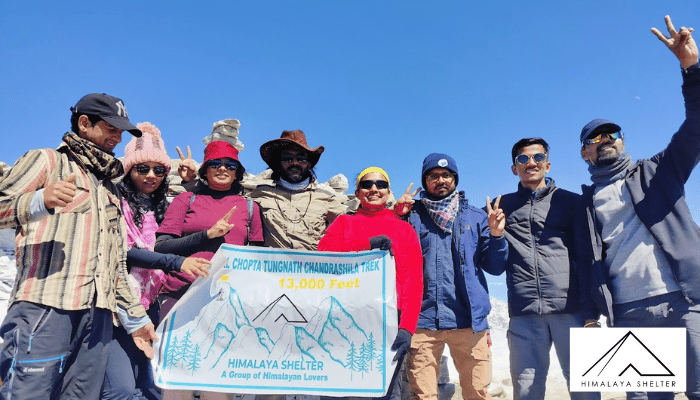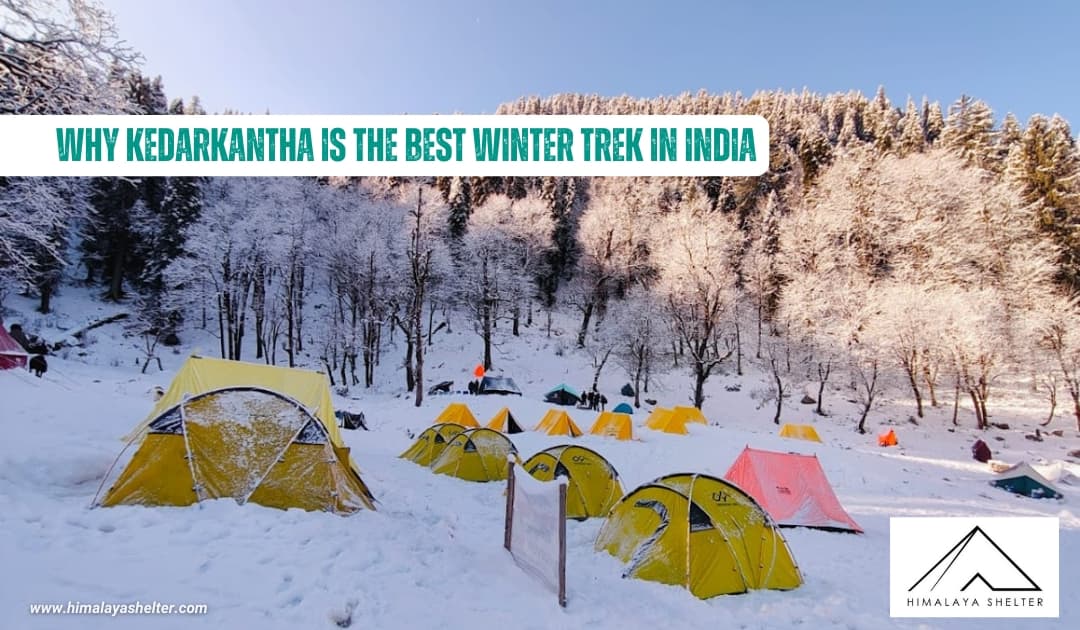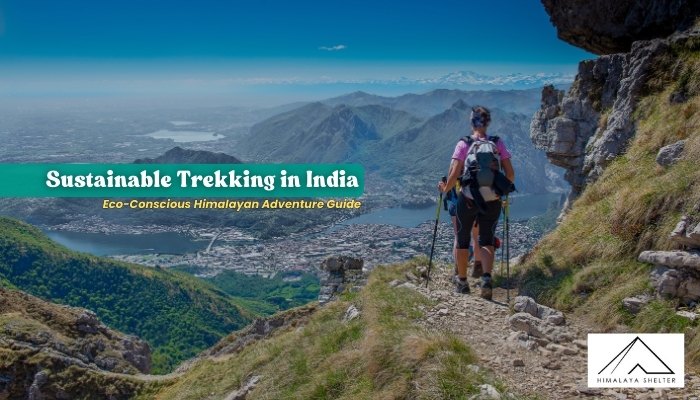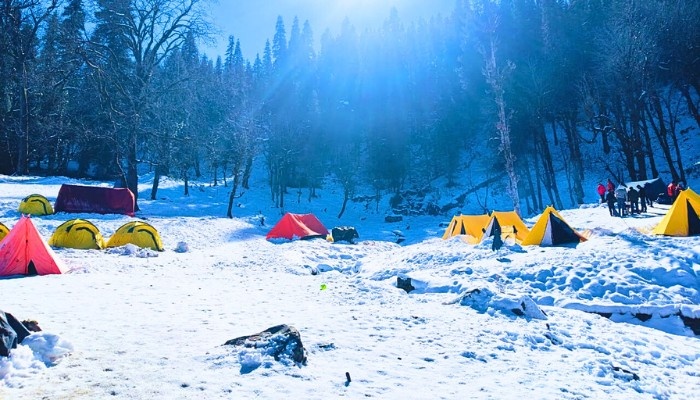
Kedarkantha Trek
TREK DIFFICULTY
Easy
TREK DURATION
5 Days
HIGHEST ALTITUDE
12,500 feet
GROUP SIZE
12
TREK DISTANCE
20 Km
BASECAMP
Uttarakhand
BEST TIME
December and January
PICKUP POINT
Dehradun
Kedarkantha Trek Overview:
Kedarkantha Trek is a beautiful hiking trail in the Garhwal Himalayas of Uttarakhand, and is located in the Govind Wildlife Sanctuary of the Uttarkashi district. This trek is one of the most popular winter treks in India and is suitable for beginners and families. The trail is also well-known among nature lovers, birdwatchers, and professional trekkers. The trail to Kedarkantha offers the experience of a tough climb to a peak, 360 degree panoramic views of the surrounding mountains, beautiful sunrise views, exploring dense forests, alpine lakes, Garhwali cultures, spiritual places and much more.
Most popular during winters, when the trail is completely covered with fresh snow, the trek is a breathtaking experience for the trekkers, as it feels like walking on the stairs to heaven. The trek starts from the quaint village of Sankri and passes through beautiful dense forests of deodar and rhododendron, the alpine lake of Juda ka Talab, several small streams, vast landscapes of alpine meadows, and a steep climb to the summit of Kedarkantha. After a slightly difficult climb, this beautiful trail offers trekkers breathtaking views of some of the amazing mountains and ranges of the Garhwal Himalayas, including Mount Swargarohini, Black Peak, Mount Bandarpunch, Ranglana, Gangotri and Yamunotri ranges.
The Kedarkantha Trek route takes about 4 to 5 days in duration to complete, which covers a distance of about 20 km. Reaching a maximum height of about 12,500 ft, the trail offers a moderate level challenges, making it suitable for both beginners and experienced trekkers.
The best time for this trek is during the winter and spring, especially in December and January, when the landscapes around the trail are fully snow-covered, creating a heavenly snowscape. However, the trek is accessible throughout the year, except during the monsoon season due to heavy rains and landslides. This trek also gives trekkers an opportunity to spend some time at a spiritual place which is believed to be the meditation place of Lord Shiva and hence the peak is named "Shiva Ka Kanth" (Kedar's Kanth) where the "Kanth" means "Throat".
At the top of Kedarkantha peak you will see a small temporary temple dedicated to Lord Shiva. Locals believe that at the Kedarkantha there was the old Kedarnath temple, although there is no concrete evidence about it. This route cannot be accessed without proper backpacking preparation. There are some rough terrains, climbing heights, unavailability of food and water, danger from wild animals living in dense forests, possibility of getting lost, uncertainty of weather and some difficult parts of the route. Trekking preparation is important so that all these types of factors can be dealt with as much as possible.
The Kedarkantha trek is offered by Himalaya Shelter in 5-day and 6-day itinerary packages, and Package cost includes facilities such as food, water, safety & security, physical fitness tips, trail permit, camping and cooking equipment, well-trained guides, route maps and basic first aid kits. This allows trekkers to enjoy the beautiful natural scenery of the trail without worrying about the logistics or other essentials needed during the trek.

Highlights of Kedarkantha Trek
Kedarkantha is one of the famous treks of winter, there are some highlights of the trek that a trekker should know. Many of the highlights are mentioned below:
1. Sankri: Base camp of The Trek:

The Kedarkantha trek starts from Sankri village, a village located in Mori Tehsil, Uttarkashi district, Uttarakhand. Rich in culture, the village offers views of mountains, rivers, and forests with lush green valleys in Govind Wildlife Sanctuary. Along with Kedarkantha, it is a famous base camp for many popular treks such as Har Ki Dun, Bali Pass, Borasu Pass, Phulara Ridge, Bharadsar Lake, Maldaru, Devkyara Bugyal, etc. It also serves as a base village for famous expeditions such as Swargarohini, Black Peak, and Bandarpunch. To reach the Kedarkantha Base Camp in Sankri, one can easily travel from Dehradun with a 200 km drive. The most popular and beautiful trail to the Kedarkantha Summit is from Sankri via Juda ka Talab, which is only 10 km in distance. However, the trek to the peak can also start from Gaichwan Gaon, a small village near Netwar. This route is longer, less frequented, and steeper in ascent to the summit of Kedarkantha.
2. Juda Ka Talab:

The Juda Ka Talab is a serene and picturesque lake nestled amidst lush pine forests, offering a breathtaking view of the surrounding landscape during the trek. The campsite of Juda ka Talab is located just a short 2-minute walk from the lake. It provides a perfect spot for trekkers to spend the night amidst nature's splendor.
The Juda Ka Talab lake freezes over in peak winters, providing a unique opportunity for trekkers to walk on its frozen surface. The trek to Juda Ka Talab from Sankri covers a distance of around 4 KM and takes 3-4 hours to complete. This makes it an ideal spot for a one-night camping experience on the Kedarkantha Trekking route.
3. Kedarkantha Base Camp:
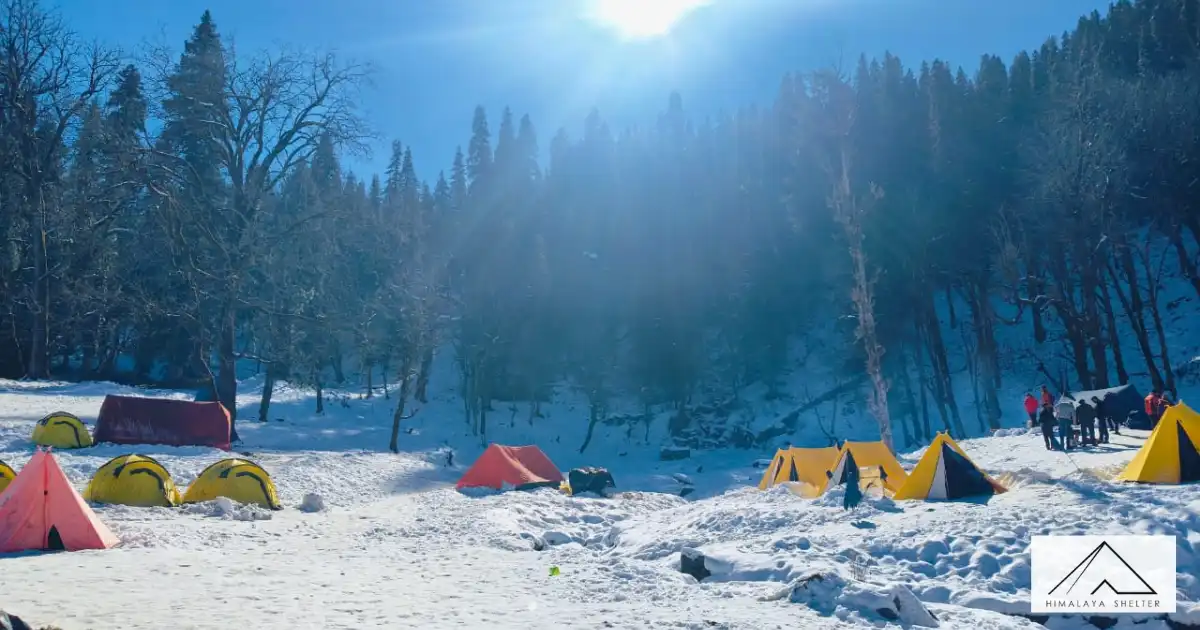
Kedarkantha Basecamp is about 3-4 hours away from Juda Ka Talab, covering a distance of 4 km, and serves as the campsite for the second night. The Kedarkantha Basecamp is situated at an altitude of 11,250 feet (3,429 meters), and from here, the Kedarkantha summit is nearly 3 km away, involving a steep ascent with a 1,250 feet elevation gain. The campsite itself is vast and requires navigating certain steep stretches to reach it. The trail section from here to the summit of Kedarkantha is very steep and can truly test trekkers' physical strength.
4. Sunrise from the Summit of Kedarkantha Peak:

Many people who have experienced the sunrise say that it's magical. There is no other view beautiful as compared to sunrise from the Kedarkantha Peak. the mesmerizing glow will leave you speechless. The first sun rays fall upon snow-capped peaks like Mt Swargarohini, Mt Bandarpoonch, and Black Peak. Which makes it a flawless view. Although some people are so mesmerized that they forget about the people around them.
You get to experience the true nature-like quietness of early morning, with thin air on the mountain. However, these qualities will make feel like you are connected to the place, connect to nature.
5. The Best Attraction in Winters:
Kedarkantha trek is famous and usually preferred during winter, which means there are many positive points of why it is a winter trek. Snow is the main factor that makes the peak more mesmerizing. In winter, Kedarkantha Summit is covered with snow, which makes it an ideal location for winter trekking. However, in winter trekkers can face some hurdles like slippery terrain which can make you slip. However, if you are properly dressed and have your gear, you are going to enjoy it 200 times better. Along with the snow, This trek includes dense Pine trees and in winter the pine trees are covered with snow which makes it look like a picture-perfect landscape for winters. How can we forget about Juda Ka Talab, it is the famous and remarkable lake that freezes during winter, it and thus it makes a special mark in trekker’s memory.
6. Cultural Exploration:
While passing through the villages, you will learn about the culture, customs, and heritage of the locals. Moreover, it's an opportunity to discover and immerse yourself in the local culture of Uttarakhand villages, and their lifestyle can help you understand the roots of this region. Additionally, you will have more meaningful interactions with the simplicity and hospitality of the people living in villages like Sankri, Saur, Sidri, Osla, Gangad, Netwar, and many other villages of Har ki Dun Valley. You can enjoy a Garhwali Thali, which includes local food items from the Garhwal Himalayas, such as Bhang Ki Chutney, Jhangore Ki Kheer, Pahari Raita, Lesu, Gahat, Kulath, Badi, Lingda Ki Sabzi, Kofta, and many more. Through cultural exploration during the trek, you will create lasting memories of the Kedarkantha Trek.
7. Wildlife on Trek:
You will find various species of birds and mammals on the Trek. that the reason the place is rich is the wildlife culture. Trekkers can spot birds like the Himalayan Woodpecker, Himalayan Monal, Rosefink, Uttarakhand's state bird, the Himalayan Partridge, which is also known as the snow Partridge, Sparrows, etc. Some mammals, if you are really lucky that you can spot on the Kdarkantha trek are; Musk Deer, Himalayan Black Bear, Himalayan Tahr, Himalayan Langurs, Leopards, squirrels, etc. Most of the time, you will be encountering Himalayan Langurs.
Day 1: Dehradun to Sankri (1,920 m): 187 km drive in 8 hours
Day 2: Sankri to Juda Ka Talab (2,774 m): 4 km trek in 3 to 4 hours
Day 3: Juda Ka Talab to Kedarkantha Base Camp (3,429 m): 4 km in 3 hours
Day 4: Kedarkantha base camp to Kedarkantha Summit (3,810 m) and back to Hargaon (2,713 m): 8 km in 5-6 hours
Day 5: Hargaon to Sankri: 4 km trek in 2 to 3 hours
Day 6: Sankri to Dehradun: 187 km drive in 7 to 8 hours
Kedarkantha Trek Package is organised by one of the most leading tour operators in India, Himalaya Shelter. This trek package is a wonderful opportunity to get into the lap of nature. The natural beauty and spirituality of the destinations included in the Trek package are associated with the Indian state of Uttarakhand, which is part of the Garhwal Himalayas.
Especially suitable for beginners and children, this 4-5 day program provides a great opportunity to connect with nature, discover one's inner self, and enhance your vacation plans. The beauty of its clearings is indescribable during the winters when the destination is covered in thick snow, so it is ideal to book this package for Christmas/New Year holidays.
Our trek packages include all the facilities needed for a successful tour experience like immersive group camping, transportation, meals, accommodation, security as well as access to tourist attractions and the great outdoor activities.
This beautiful trek package can be booked at affordable prices and will give you a chance to explore the fascinating region of Devbhoomi - Uttarakhand, while enjoying beautiful moments with friends and loved ones. One can check the available dates for trekking groups, the itinerary, duration, and the package inclusions of services provided by Himalaya Shelter.
Dynamic or Customised Package Options for the Kedarkantha Trek:
Himalaya Shelter allows guests to create their own customised package of transportation, accommodation, food menu, guide and other add-ons like mule or porter assistance to carry luggage, custom itinerary and duration, more tourist attractions or activities etc. Kedarkantha trek package can be booked to enjoy the hidden gems and soothing mud of Devbhoomi Uttarakhand with preferred dynamic packaging for which guests can use a company itinerary or can also create a custom program with a private group of family members or friends. This option will make your personal vacation plan even more wonderful while staying away from the hustle and bustle of Kedarkantha trail.
The Kedarkantha trek is considered a moderately challenging trek based on the experience of the trekkers and the terrain sections, making it suitable for experienced trekkers as well as beginners. The elevation of the trail increases gradually and follows a well-defined trail that is not too technical, either. The maximum elevation is only 12,500 ft. However, the risk of AMS (Acute Mountain Sickness) is not zero, so it is important to be prepared with your AMS medicines and other essentials.
Although it does not require extreme physical fitness, and beginners can manage it with some prerequisites, there are a few notes about the difficulty factors to keep in mind. For instance, the last section, when trekkers climb to the summit, is a steep climb, heavy snowfall in extreme winters and AMS and related diseases due to low levels of oxygen at such a high altitude.
These three major factors add to the difficulty of the trail and classify this trek as a ‘moderate level trek’. Physical preparation before starting the trek is important to deal with some of these difficulty factors, like the steep climb to the summit and heavy snowfall that makes each step more challenging. Do cardio, body weight exercises, core exercises, balance training and yoga to improve physical fitness.
During the peak winter season, the temperature drops below zero at night and remains between 5 to 15 degrees Celsius during the day, so to deal with the extreme weather, it is necessary to be prepared with suitable gear like padded jackets, fleeces and thermal inners. Good physical fitness and following safety precautions and protocols during the trek will help you manage all the difficult sections as much as possible.
This trek is generally accessible for 9–10 months of the year. However, it is not recommended to trek during the monsoon months of July and August due to incessant rains, which can make the trek risky. The most popular time to visit Kedarkantha Trek is in the winter months of December and January.
During these months, heavy traffic of trekkers can be seen on the trail. During peak winters, sometimes there is continuous snowfall, and walking on the path becomes quite difficult due to the fresh snow. At this time, excessive snowfall in Kedarkantha may cause the trek to be closed for a few days in the last week of December and the first week of January.
But overall, the trek route is considered safe during all other times of the year, except the monsoon.
1. Kedarkantha Trek from September to November (Autumn):
In September when warm, sunny days and pleasant temperatures hovering around 20 to 25 degrees Celsius. The evenings are cool and breezy, and the meadows are in full bloom, with a variety of flowers and wild berries growing all around the trail of the Kedarkantha Trek. Rainfall is minimal, with short showers expected only post-afternoon on some days.
In October, the evenings become colder, and the landscape changes to a cinnamon autumn hue. In the previous year, 2021, the Kedarkantha Trek witnessed snowfall for two days during the third week of October, which is rare but possible.
By November, temperatures begin to slide to 0 or even sub-zero at night at the Juda ka Talab and above campsites. There is more snowfall than expected, starting from the first week of the November month.
2. Trek in December, January, February, March, and April (Winter and Spring):
December to February is the best time to really enjoy the Kedarkantha Trek, when the finest snowfall of the season occurs. The entire trail is covered with snow during this time, which adds to its beauty. The path becomes a little difficult during this period, but beginners can still complete this trek. During this time, the trees are laden with snow, the landscape looks like pristine white meadows, and the view of the mountains surrounding the trail appears heavenly. Although it is mostly cloudy during this season, if you are lucky and the sky clears, the snow-covered landscapes become even more stunning with a bright white hue that is sure to bring you immense pleasure.
While the period from December to February is the best time to go on this trek, the weather conditions can affect trekkers if they are not adequately prepared. The temperature during this time ranges from 15 to 5 °C during the day and 0 to -5 °C at night. To withstand this harsh weather, one should be prepared with at least four layers of clothing, especially at Kedarkantha Basecamp (11,250 feet) and higher altitudes, where the temperature can drop to -10 °C and even lower.
In December, Many trekkers plan their trip during the Christmas and New Year's holidays. By the second week of December, snow usually covers the landscape up to the base camp of Kedarkantha Trek. Also, there is some snow at Juda Ka Talab. By the end of December, the landscape around the trail turns into a winter wonderland, with tall pine trees and shrubs covered in thick snow. Campsites are whitewashed under a snow blanket. Temperatures drop below 0 degrees Celsius in the month of December, and Juda Ka Talab freezes completely, making it possible to walk on the frozen lake.
January receives the most snowfall on the Kedarkanth Trek compared to other winter months. On the upper end, temperatures range from 7 to 8 degrees Celsius. On the lower end, temperatures drop to minus 10 degrees Celsius at higher campsites of the trek like Kedarkantha Basecamp and the Summit of Kedarkantha Peak. Especially in Sankri, Snowfall can even lead to temporary suspension of the Trek.
February sees less snowfall, but the landscape above the Kedarkantha basecamp is still covered in snow. Juda Ka Talab Lake begins to melt, and temperatures become more bearable, making it a great time to plan this trek. Snow starts to recede at lower altitudes around Juda Ka Talab by the end of February and the starting of the March. At the beginning of March, temperatures hover around 0 degrees Celsius.
By mid-April, new vegetation begins to bloom, but there is still a good amount of snow around the tril. The weather in Kedarkantha Trek is pleasant during this time , with temperatures averaging around 10 degrees Celsius during the day. At night, temperatures drop to around -2 degrees Celsius in upper campsites of the trek.
3. Kedarkantha Trek in May and June (Summer):
May and June are less frequented months for this Trek as trekkers prefer other summer treks nearby like Har ki Dun Trek, Phulara Ridge Trek, Bali Pass Trek, Rupin Pass Trek and so many other treks. Also, these treks start from the Sankri Basecamp.
The route usually follows this sequence: Sankri → Juda Ka Talab → Kedarkantha Base Camp → Kedarkantha → Hargaon → Sankri. This route is well plotted on a map showing how all these campsites or stop points relate to each other in terms of distance and elevation gain & loss.
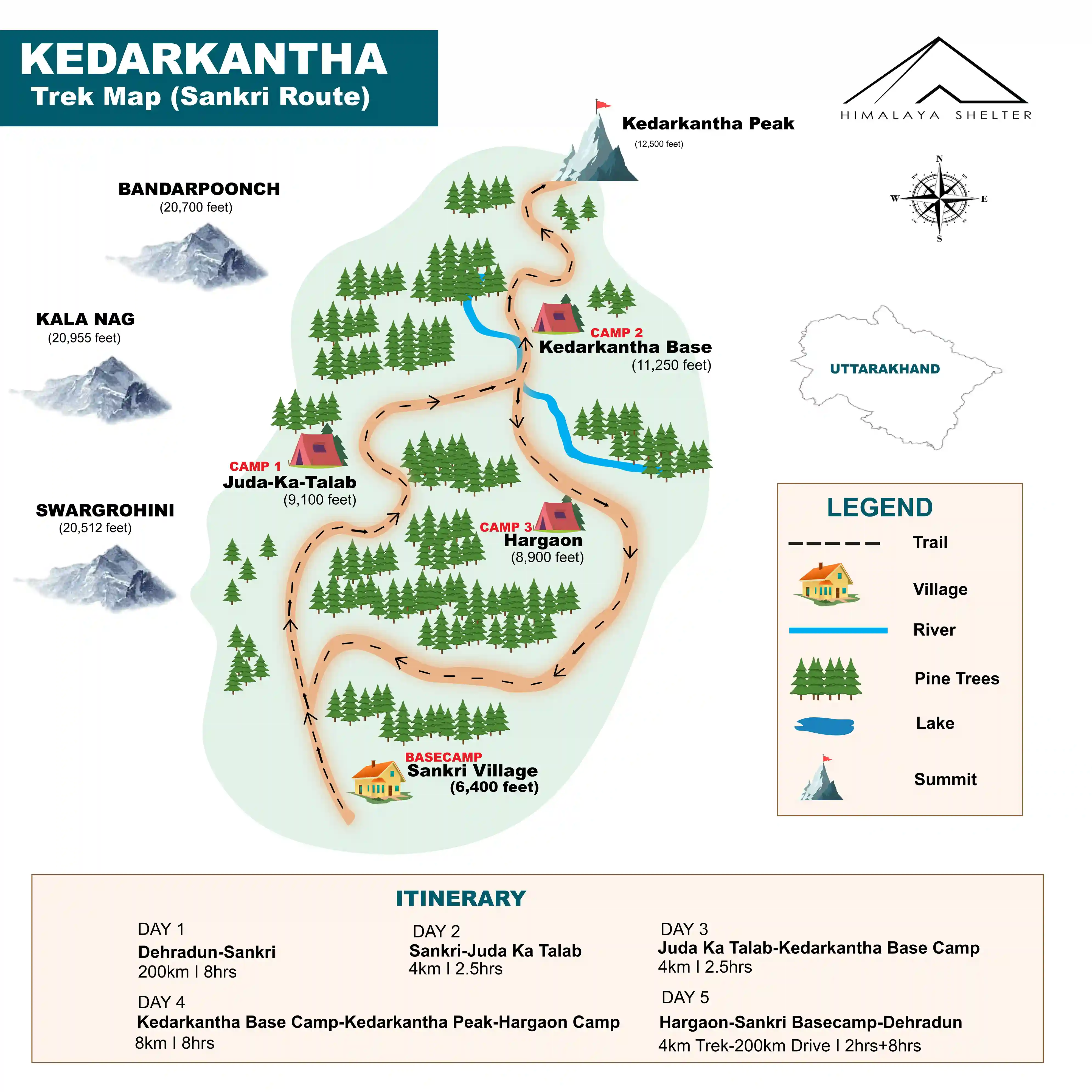
If you are planning to visit Kedarkantha Trek, you have to be aware of the route and ways of traveling. To start the Trek, you first have to reach Dehradun and then continue your journey towards the base camp of the trek. Trekkers should be aware that Sankri village serves as the basecamp of this Trek.
Traveling to Dehradun:
There are three ways to reach Dehradun and all of them are mentioned here:
-
By Air:
Many people go with the by-air option, which is to travel by flight. This is costly but for sure it saves a lot of time. If you travel by flight directly to Dehradun, you will land at Jolly Grant Airport. Dehradun bus stand is 30 km away from the airport and after reaching the airport, you need to book a cab to reach the Dehradun bus stand. -
By Road:
If you want to travel by road, you can take Volvo and other buses too. Traveling through the road can take more time compared to a flight, however, this may cost you less than the flight. If you travel by road, you will directly reach the Dehradun bus station, and from there, you can get a bus to travel further. -
By Train:
You can reach Dehradun by train. The Nanda Devi Express, or Kota Express, departs from Kota at 5:55 p.m. and reaches Dehradun the next morning at 5:45 a.m. However, this timing coincides with the departure time of buses and taxis leaving Dehradun for Sankri early in the morning.
Dehradun to the basecamp Sankri:
Make sure you reach the base camp by 10 a.m. so you can start your trek on time. The distance from Dehradun to Sankri is 190 km, so it is suggested to arrive a day prior for an overnight stay in Sankri.
-
Private and Govt. buses:
To reach Sankri from Dehradun, there are both Govt. and private buses, so you can choose whichever you prefer. However, to reach Sankri, the time distance is 7 to 8 hours, and departure from Dehradun before 8 am is essential because after 8 am there are no direct vehicles to reach Sankri. -
Regular Taxis and cabs:
The second option you have is to opt for a taxi or cab from Dehradun to Sankri. Moreover, the taxis provide you services up to Purola, and from Purola, you can have another bus or taxi to reach Sankri basecamp.
Choose whichever way is comfortable for you, plan the Kedarkantha Trek accordingly and enjoy the mesmerising views of the Himalayas.
This is a pictorial description of the kind of terrain one is likely to encounter while undertaking Kedarkantha trek.
- Starting Point: From Sankri, some gradual slopes through the oak and pine trees.
- Forest Trails: It passes through deep pine, oak and fir staples. Crossings can be done on water, trails can be very muddy and sometimes to the extent of being slippery.
- Meadows and Clearings: Goes in to open up meadows specially at Juda Ka Talab, with wide open spaces with lots of grassy fields and a great view.
- Snow-Covered Paths: The cross-country trails are covered with snow during winter and early spring. Trekking is not easy due to distinctly different snow conditions. Trekking poles, gaiters, and microspikes are useful.
- Steep Ascent to Base Camp: Hike from Juda Ka Talab to the Base Camp with short steep steps on stones and rocky terrains with many hairpin bends. Views improve with altitude.
- Summit Push: The last trek to reach Kedarkantha is difficult which is steep and path is completely open and many at times it is snow or ice. Must be managed and does require one to have lots of energy.
- Descent: Journey through from meadows and the forest trails. Still a moderately easy hike compared with ascent but a shocker, for knees especially because the slopes are steep.
- Overall, Terrain: It has forest tracks, meadows, and alpine; country characteristics. Varied and interesting trekking experience with different terrains.
If you’re physically fit and aware of the safety precautions for the Kedarkantha Trek, you’ll experience the beauty of the trek 200% more effectively compared to those with weaker physical fitness and insufficient knowledge of safety precautions. This preparation enables you to fully enjoy the majestic landscapes and challenging trails without being held back by fatigue or physical limitations.
Preparation for a Good Physical Fitness:
To overcome the difficulty level of this trek, it requires strong cardiovascular endurance, muscular strength, and overall fitness. Incorporate these exercises into your routine to increase strength, stability, and stamina, which will help you tackle the difficult terrain of the trail at high altitudes.
1. Lower Body Exercises:
-
Squats:
- Target Body Parts: Quadriceps, hamstrings, glutes, calves.
- Benefits: Strengthens lower body for climbing and descending; stabilizes uneven terrain.
- How-to: Stand feet shoulder-width apart. Lower into a squat, keeping your back straight, then return to standing.
-
Lunges:
- Target Body Parts: Quadriceps, hamstrings, glutes, calves.
- Benefits: Improves balance and stability on rocky trails; enhances flexibility.
- How-to: Step forward with one foot, lowering your body until both knees are bent at 90 degrees. Push back to start and alternate legs.
2. Upper Body Exercises:
-
Push-Ups:
- Target Body Parts: Chest, shoulders, triceps, core.
- Benefits: Strengthens upper body for backpack support and improves posture.
- How-to: Start in a plank position, lower your chest to the ground, then push back up, keeping your core engaged.
-
Pull-Ups/Bodyweight Rows:
- Target Body Parts: Back, biceps, shoulders.
- Benefits: Enhances posture and reduces back strain; strengthens muscles for carrying a backpack.
- How-to: For pull-ups, grip a bar and pull yourself up until your chin is above it. For rows, use a low bar or TRX straps.
3. Core Exercises:
-
Planks:
- Target Body Parts: Abdominals, obliques, lower back.
- Benefits: Improves stability and balance; reduces back pain.
- How-to: Hold a plank position with elbows under shoulders and body in a straight line.
-
Russian Twists:
- Target Body Parts: Obliques, abdominals, lower back.
- Benefits: Enhances rotational stability and core strength.
- How-to: Sit with knees bent, lean back slightly, and twist your torso side to side.
4. Full Body/Cardiovascular Exercises:
-
Mountain Climbers:
- Target Body Parts: Core, shoulders, chest, legs.
- Benefits: Improves cardiovascular endurance and agility.
- How-to: In a plank position, alternate bringing knees to chest in a running motion.
-
Burpees:
- Target Body Parts: Full body.
- Benefits: Boosts cardiovascular endurance, strength, and agility.
- How-to: Perform a squat, jump to a plank, do a push-up, return to squat, and jump up.
5. Additional Tips:
- Consistency & Form: Maintain proper technique and gradually increase intensity.
- Recovery & Flexibility: Allow muscle recovery, and stretch before and after workouts.
- Balance Training: Incorporate strength exercises like deadlifts for overall balance and endurance.
Regularly performing these exercises will build the necessary strength and stamina for a successful trekking experience. Good fitness is crucial for tackling the challenges of the Kedarkantha Trek and fully appreciating the adventure it offers.
Before going on the Kedarkantha trek you need to have the best knowledge on how to prepare for a Himalayan Trek with a perfect backpacking of gear and equipment required, so that you can enjoy the trek without worrying about the common requirements otherwise lack of proper backpacking preparation can lead to the worst experience of your beautiful trek. Follow the instructions below to pack your backpack for hiking-
1. Mandatory Documents:
Ensure you carry essential documents such as a valid ID proof (driver’s license, Aadhar Card, or passport), medical fittness certificate and an adventure insurance.
2. Accessories:
Bring along a sturdy Backpack with rain cover, Waterproof Shoes, trekking poles, sun cap, sunglasses, headlamp or flashlight, lunch box, water bottle, a trek route map & current weather forecast of the the trail' region. Don't forget to carry a camera to capture the scenic beauty of Kedarkantha Trek, and a power bank for charging electronic devices.
3. Toiletries:
It's essential to bring basic toiletries to ensure personal hygiene and comfort during the trek. Pack biodegradable soap a toothbrush and toothpaste, deodorant, tissues or wet wipes, hand sanitizer, lip balm, sunscreen, a small towel, and a comb.
4. Clothing:
Wear multiple layers of clothing to suit different temperatures. The best Packing of essential clothing for a Himalayan Trek is key point to fully enjoy your trek without much affacted by the harsh weather. Always Try to pack as many items as possible that are moisture-wicking, warm, waterproof and comfortable.
- For trekking in spring, summer, and monsoon: 1 Trek Pant, 1 innerwear (made of nylon), 1 lightweight shirt, 1 fleece Sweater, and 1 poncho
- For Trekking in Autumn, and starting of Winters: 1 Trek Pant, 1 pair of thermals, 1 t-shirt, 1 fleece Sweater, 1 padded jacket, and 1 poncho
- For Trekking in Winters: 1 pair waterproof gloves, 1 Trek Pant, 1 pair of thermals, 1 t-shirt, 1 fleece Jacket, 1 padded jacket, and 1 windproof jacket
Extra cloths as per the duration of Kedarkantha Trek
- 3 T-shirts (Wear one, carry two)
- 2 pair thermals (Wear one, carry one)
- 2 quick-dry trek pants (Wear one, carry one)
- 3 pair socks (Wear one, carry two)
- 2 pair gloves (Wear one, carry one)
- 1 padded Jacket (Always carry it in your bag, whether you are wearing it or keep it with you in case there is a sudden drop in temperature during evening and morning hours)
5. Medical Kit:
Carry a basic First Aid Kit, including bandages, antiseptic wipes, pain relievers and any personal medications. It's also helpful to have altitude sickness tablets and a blister care kit.
The challenging terrain requires careful planning and adherence to safety precautions to ensure a safe and enjoyable trekking experience. Here is a list of 11 essential safety precautions and protocols for the Kedarkantha Trek:
1. Acclimatization:
- Importance: Acclimatization helps stabilize oxygen levels in the body. It is crucial for preventing altitude sickness and maintaining physical fitness.
- Protocol:
- Spend an extra day at the Sankri base camp or intermediate points to adjust to the altitude.
- Ascend gradually, avoid ascending too quickly.
- Summit, Climb high and sleep low. After reaching the campsite, hike to a higher elevation than the campsite's altitude, spend some time there, and then return to the campsite.
- Reduce strength exercises and increase yoga practice with Pranayama or other slow breathing techniques.
2. Weather Preparedness:
- Importance: The weather in Kedarkantha can be unpredictable, with snow and cold temperatures. Knowing weather facts helps trekkers determine the best time to start or not start their trek, and be prepared for any expected weather fluctuations during the hiking.
- Protocol:
- Check weather forecasts regularly.
- Be prepared for sudden changes by carrying appropriate gear, such as waterproof jackets or a poncho, and extra pairs of quick-dry socks.
- In the mountains, afternoon rain is more common than other times of the day. So, make sure to start and end your hike before noon.
- If it’s raining continuously, pause on the hike on the spot but avoid stopping near water streams and riffle sections. Try to pass away these areas as quickly as possible.
3. Hydration and Nutrition:
- Importance: Staying hydrated and well-nourished helps maintain energy and health.
- Protocol:
- Drink plenty of water at regular intervals throughout the trek.
- Carry high-energy, easy-to-digest foods like nuts, energy bars, and fruits.
- Avoid taking alcohol.
- Avoid consuming sugary foods or drinks during the trek. Excess sugar increases blood glucose concentration, leading to fatigue.
4. Health and First Aid:
- Importance: Immediate response to health issues can prevent serious complications.
- Protocol:
- Carry a comprehensive first aid kit, including altitude sickness medication, and be familiar with basic first aid procedures.
- Inform your trek leader of any pre-existing health conditions.
5. Safety Gear:
- Importance: The right gear can prevent injuries and keep you safe in adverse conditions.
- Protocol:
- Wear sturdy, broken-in trekking boots with good ankle support.
- Dress in layers to manage your body temperature, especially above the Kedarkantha Base Camp.
- Carry a reliable backpack with a rain cover and other essentials such as a headlamp, rope, oxygen cylinder, gaiters, and microspikes.
6. Emergency Preparedness:
- Importance: Quick action is vital in emergencies.
- Protocol:
- The nearest hospital is located in Mori, which is 21 km from the Sanrari Base Camp.
- Keep emergency contact numbers.
- Ensure that your trek leader has communication devices such as a satellite phone or walkie-talkie in case of an emergency.
- Make sure you have appropriate adventure insurance that covers trekking in high-altitude areas.
7. Navigation and Trail Safety:
- Importance: Navigating snowy trails requires caution and skill.
- Protocol:
- Follow your guide.
- Follow marked trails and use a compass, maps, or GPS devices to avoid getting lost on the trail.
- Pay attention to trail markers and avoid venturing off the path.
8. Wildlife Awareness:
- Importance: Encounters with wildlife can be a risk.
- Protocol:
- Maintain a safe distance from animals.
- Avoid leaving food unattended and keep your campsite clean to avoid attracting wildlife.
9. Group Coordination:
- Importance: Staying connected with your group ensures collective safety.
- Protocol:
- Maintain regular communication with your group.
- Follow the trek leader’s instructions and avoid separating from the group.
10. Environmental Responsibility:
- Importance: Protecting the natural environment is essential.
- Protocol:
- Follow "Leave No Trace" principles.
- Dispose of waste properly and avoid disturbing wildlife or vegetation.
11. Altitude Sickness Awareness:
- Symptoms: Headache, nausea, dizziness, and shortness of breath.
- Protocol:
- If symptoms occur, inform your trek leader immediately.
- Descend to a lower altitude if necessary and seek medical help if symptoms persist.
- On the Kedarkantha Trek, after crossing the Kedarkantha Basecamp (11,250 feet), some trekkers might be affected by AMS. Therefore, keep your walking pace slow and steady until you reach the summit.
Adhering to these safety precautions and protocols will help ensure a safe and memorable experience on the Kedarkantha Trek. Proper preparation and awareness are key to navigating the challenges of this beautiful Himalayan adventure.
Day 1: Dehradun to Sankri (1,920 m): 187 km drive in 8 hours

The drive from Dehradun to Sankri takes you through picturesque towns and villages like Mussoorie, Nowgaon, Purola, and Mori. The route is scenic and takes you through a dense pine forest, filling the air with the sweet aroma of pines. After driving through the forests, you’ll reach Mori, where the Tons River joins you on the route. The Tons River is the biggest tributary of Yamuna and is well-known for rafting activities. The 190 km long drive typically takes 8-9 hours to complete, so it’s advisable to start early to reach Sankri by evening. You’ll spend the night at a guesthouse before starting your hike the next day.
Day 2: Sankri to Juda Ka Talab (2,774 m): 4 km trek in 3 to 4 hours

We start our trek towards Juda Ka Talab early in the morning after breakfast from Sankri. The trek is an eventful one as we pass through local villages, such as Saud, and encounter kids heading to school and women starting their daily chores. The trail takes us through a dense pine forest, which gradually steepens until we reach a ridge. After walking on the ridge for a while, the trail evens out and widens. The thick forest provides a cool environment, shielding us from the sun’s heat. Finally, we reach the famous Juda Ka Talab, a small lake adorned with three floating landmasses. We camp by the lake, savoring a starry dinner.
Day 3: Juda Ka Talab to Kedarkantha Base Camp (3,429 m): 4 km in 3 hours

From Juda Ka Talab, the trail leads deeper into dense pine forests until reaching a meadow with shepherd’s huts. Summit Climbing further for another thousand feet, trekkers will finally reach the Kedarkantha base camp, taking around 2-3 hours to complete. The trail from Juda Ka Talab to the base camp is incredibly stunning, providing an ideal setting for photographers and nature enthusiasts alike. Despite being a bit colder due to the lack of insulation, the base camp offers panoramic views of the famous peaks of Uttarakhand, making it an ideal spot for camping.
Day 4: Kedarkantha base camp to Kedarkantha Summit (3,810 m) and back to Hargaon (2,713 m): 8 km in 5-6 hours

Day 4 is the day you’ve been waiting for! The trek to the summit from the base camp is not long, and upon reaching the top, you’ll be rewarded with a jaw-dropping 360-degree view of the Uttarakhand peaks, the Chaainsheel Pass, and the Kailash ranges of Himachal. You can even see the Har Ki Dun valley below. The Kedarkantha summit is marked by an arrangement of stones with a Trishul pointing to the sky. Legend has it that the peak was meant to be the original Kedarnath temple, but Lord Shiva, who was disguised as a cow hiding from the Pandavas, was disturbed during meditation by the villagers. The interruption made him change his location to the present Kedarnath temple.
After spending time on the summit, we hike back to the base camp and head towards Hargaon (2 km trail) post-lunch. Hargaon is a large camping area en route to Sankri, where we will spend the night before bidding farewell to this beautiful place.
Day 5: Hargaon to Sankri: 4 km trek in 2 to 3 hours

Today is the final day of our trek and we will descend from Kedarkantha to Sankri, which is a 4 km trek taking 2-3 hours. Once we reach Sankri, you can take the rest of the day to explore the charming village and nearby villages like Gangad and Osla, which are known for their warm hospitality and traditional Pahari culture. Sankri is also the last road head to the Govind Balabh Pant Wildlife Sanctuary.
Day 6: Sankri to Dehradun: 187 km drive in 7 to 8 hours
Going back home is always a bittersweet moment, but the journey is made easier by taking the same picturesque road back to Dehradun. As we leave behind the dense pine forests and descend towards the city, the landscape slowly changes and opens up into wider roads. Finally, we arrive in the bustling city, bidding farewell to the serene mountains and valleys of Uttarakhand.
Our treks are specially designed by the experienced team at Himalaya Shelter, taking you on an adventure of a lifetime all while making you connect not only with the bountiful nature but also with yourself and with others on the trek with you creating wonderful memories which will last you a lifetime. All Himalaya Shelter treks are guided by experienced Trekkers having vast knowledge and experience of the region, providing with insightful information and stories pertaining to the region’s flora and fauna and the history of the region whilst the trek. It is safe to say that on successfully completing the trek, one will gain tremendous insight and experience along with lifetime memories.
Trek Inclusions
- Transportation – Day 1: Driver from Dehradun to Sankri. Pickup time: 7:30 am, Pick Up Point: Prince Chowk, near Dehradun Railway Station
Last Day: Drive from Sankri to Dehradun. Expect to reach Dehradun by 6:30 PM. - Accommodation – At Base Camp, stay at a local homestay or guest house for one night each, which will give you an insight into the authentic lifestyle of the locals.
- On Trek stay in a 2-person Vango Halo Pro/A-Shape tent, which is to be shared by two trekkers, built to withstand extreme weather conditions and at the same time making you comfortable after a hard day’s trek.
- Camping Equipment – specially designed sleeping bags that can withstand harsh weather conditions, foam mattresses. Other safety gear like microspikes, gaiters, an ice axe, and helmets will be provided.
- Medical Kit – our team will be equipped with an extensive medical kit, which our team is trained and experienced to use. Oxygen cylinders are used after they are thoroughly inspected throughout the Trek. Even campsites have large oxygen cylinders as backups.
- Permission - Forest entry charges for Indian nationals (Additional charges will be applicable for international tourists)
- Meals – Breakfast, packed lunch (on trek days), evening snacks, and dinner will be served. A hearty, delicious, and nutrition-filled Veg meals with egg preparation will be provided throughout the trek. (Jain and Vegan Food can also be arranged on prior notification). There will be a dedicated Kitchen Tent along with a dining tent, which will have a dining table too.
- Our Team – A highly experienced and AMC-certified Trek Leader who will help ensure that the entire trek goes smoothly and safely while navigating the challenging conditions during the trek, and is skilled enough to navigate any medical emergency that can arise during the trek. Local and route guides who are well-versed with the region and provide an in-depth insight into the local customs and knowledge of the flora and fauna endemic to the region. A dedicated Kitchen staff, which includes a Cook, a helper, and other support staff. There will also be porters and mules to carry common equipment.
- CLOAKROOM - We have a cloakroom facility available for extra luggage. Every trekker is permitted to leave their luggage behind at no charge.
Exclusions
- Personal expenses like tips, personal medicines, phone calls etc.
- Travel Expenses - Travel expenses from your hometown to the mentioned Pick-Up Point are not included in the trek fee.
- From the scheduled pick-up spot to the base camp, we have our own fleet of vehicles like Bolero, Innova, Dezire, or Tempo Traveler (12-seater). This is be shared by trekkers for a pre-decided amount. All vehicles are non-AC.
- Personal Equipment - Any personal gear like jackets, shoes, cutlery, or backpacks are not included in the trek fee. We recommend renting them from our Rental Store for an affordable fee. This can be pre-arranged to avoid last-minute hang-ups.
- Offloading - We encourage carrying your backpack to get into the true spirit of trekking. However, if needed, you can opt to offload your personal luggage of up to 12 kgs for an additional cost of INR 400 per bag per day.
- Trek Insurance - A mandatory trek insurance fee is charged in addition to your trek fee. Since most medical insurance doesn’t cover adventure activities, trek insurance offers essential coverage, enhancing your safety without a significant financial burden.
- Buffer day on the trek - We have kept a buffer day on the trek to account for any weather-related delay. If this is utilized, you will need to pay an extra amount to your trek leader.
- Anything apart from inclusions
- Please carry a lunch box for a packed lunch/breakfast to avoid using polythene and Aluminium foil.
Keeping the Himalayas clean is our own responsibility. Reduce the use of Plastic when you are in the abode of the Sacred Himalaya. 🌱
Kedarkantha Peak in Winters:- Adequate Clothing Includes – Appropriate Base Layers – i.e. Warmers (avoid cotton warmers/inner wear and choose synthetic or woolen base layers) Warm Layer including One Padded or Down Jacket and a fleece or sweater A Thin waterproof jacket to protect from Snow, Rain, or wind (Alternatively you can carry a waterproof warm jacket such as a Snow Hiking Jacket which serves the purpose of being warm and waterproof both) Two Synthetic Trek Pant/Lowers (avoid jeans, cotton lowers) Waterproof Pants (Optional, if using gaiters) 1 Warm lower (preferably fleece) for overnight wearing in camp Equipment & Protective Clothing such as Waterproof and Warm Gloves Trekking Pole Micro Spike (Provided by us) Gaiters (Provided by us) Head Lamp Sun Cap Woolen Cap/ Scarf Neck Gaiter/Balaclava Sunglasses (Preferably Polarized if trekking in winter) Waterproof High Ankle Shoes 3-4 pairs quick drying socks 1-2 pairs of woolen socks Quick Drying Towel
I have been doing treks with Himalaya Shelter for the last two years and they are awesome people with pure humbleness. We at Himalaya Shelter consider our trekkers part of our community, a family of sorts and really understand the efforts that you put into taking that much-needed break and setting off to the mountains.
Some of you may wait for months and even a year to plan out that perfect excursion. That’s why we want it to be “a perfect excursion” for you. Our testimonials (read below) are a testament to our service-oriented mindset. We take safety into great consideration and ensure our team is trained to handle emergency situations.
For a better experience, we provide accommodation on Twin Sharing throughout the trek. With most trekking operators you would get triple or even quad sharing accommodation. Our Accommodation will have attached washrooms (In Sankri on 1st and 5th Night) Furthermore, we provide the essential safety gear for your trek – – Crampons – Gaiters Without any additional charges.
We pamper you with great food which keeps you going on the trek. (On our google maps out of 300 reviews over 80 Trekkers mention great food😋) We do not outsource services to ensure topmost quality throughout your journey. We use our own fleet of Vehicles to ferry you to the base camp and return.
Lastly, being a local operator we are direct stakeholders in the economic and social development of Uttarakhand. Employing locals and helping them progress in their lives goes hand in hand with work. Thus choosing Himalaya Shelter, is a step in helping us help locals progress by ensuring financial independence and social progress.
The trek pickup point will be near Dehradun railway station. The exact location will be shared with you prior to departure day. The departure time remains 7 AM sharp for every group departure. Trekkers arriving by Flight should ideally arrive 1 day in prior.
The Airport (Jolly Grant) is situated at least 1 hour drive away from Dehradun Railway Station in the opposite direction. If you’re arriving by flight it is thus advised to travel a day prior due to lack of early morning flights.
The Kedarkantha trek typically starts from the Sankri village to Juda Ka Talab. It is about 4-5 km. From Juda Ka Talab to Kedarkantha Base Camp, it is around 4-5 km. The trail leads through meadows with panoramic mountain views.
Then, Kedarkantha Base Camp to Summit is roughly 6-7 km. And finally, Hargaon to Sankri is about 4-5 km. The total trek distance is approximately 20-24 km.
The Kedarkantha trek price is influenced by various factors such as the time of year, trek duration, group size, and preferences in accommodation and services. You can expect the budget cost between INR 6,000 and INR 12,000 per person for a 4-5 day trek. This cost typically covers:
Transportation to and from the trek’s starting and ending points (Sankri / Dehradun / Delhi) All meals & Accommodation throughout the trek Trekking equipment like Kitchen tent, Dining tent, Toilet tent, etc Sleeping bags, Mattresses, Camping stools, Trekking permits and fees Services of an experienced trek guide and support staff Basic First Aid kit Opting for a group trek is an alternative approach to reduce the overall trek cost.
It’s an effective way to cut down on transportation and accommodation expenses. Furthermore, certain operators extend discounts, catering to budget-conscious travelers.
The distance from Delhi to Kedarkantha is about 433 km. It takes about 11 to 12 hours of driving from Delhi to Sankri and 10 km of trekking from Sankri to Kedarkantha Peak. There are three ways to reach the Sankri trek from Delhi. Kedarkantha from Delhi by Road:- Bus: Direct buses run between Delhi and Dehradun.
They depart from the central bus station in Delhi and arrive at the main depot in Dehradun. Upon reaching Dehradun, you can board another bus that will take you directly to Sankri. After arriving in Sankri, you’ll need to start a 10 km trek to reach Kedarkantha Peak, a journey that typically spans 1 to 2 days. Kedarkantha from Delhi by Air:- To reach Kedarkantha from Delhi by air, simply catch a direct flight from Delhi Airport to Jolly Grant Airport in Dehradun.
Upon arrival at Jolly Grant Airport, you’ll find a multitude of taxi services available at the exit, ready to take you to Dehradun. From Dehradun to Sankri drive takes around 7 to 8 hrs. Upon reaching Dehradun, you can board another bus that will take you directly to Sankri.
After arriving in Sankri, you’ll need to start a 10 km trek to reach Kedarkantha Peak, a journey that typically spans 1 to 2 days. Kedarkantha from Delhi by Rail:- It’s recommended to opt for the overnight Kota Express, also known as Nanda Devi Express, departing at 11:50 PM, and arriving in Dehradun at 5:45 AM, aligning with other transportation schedules from Dehradun to Sankri.
Yes, you can go for the Kedarkantha trek in December. It’s a popular winter trek in India. From December to March, the trek is all covered in snow, making it very special. But, it can be a bit hard, especially if you’re new to trekking.
Kedarkantha weather in December might suddenly change, and there could be a lot of snow and strong winds. The paths can also be slippery. If you’re thinking of going on this trek in December, it’s really important to be well-prepared and go with a good trekking group. Bring warm clothes, strong shoes, and other things you’ll need for trekking.
To get to Kedarkantha from Dehradun, first, you need to reach Sankri. Once you arrive in Sankri, begin the trek to Kedarkantha summit, which is approximately 10 km away from Sankri. How to Reach Sankri from Dehradun:- Every morning, a limited number of shared cabs and buses depart for Sankri from the vicinity of Dehradun Railway Station. Govt. Buses and Private Buses- Only one government bus departs from Dehradun Railway Station to Sankri at 8:00 am. Additionally, two private buses leave around 7:00 am from just outside the Dehradun Railway Station heading to Sankri town.
The fare for this journey is approximately Rs. 400 per person, which is roughly the same for both the government and private buses. Private Cab or Taxies- You can easily locate shared taxis near Hotel Milan or Hotel Grand, merely a 2-3 minute walk from Dehradun Railway Station. These taxis operate up to Purola, which is 54 kilometers away from Sankri.
The journey lasts approximately 5 to 6 hours, with a fare of Rs. 400. From Purola, you’ll find shared cabs to take you directly to Sankri. However, it’s crucial to bear in mind that these cabs typically depart before noon. Hence, plan to reach Purola in the morning if you choose this route.
The cab fare from Purola to Sankri ranges from 200 to 300 rupees. (This fare is applicable only when the taxi is full of passengers; otherwise, the cost may vary based on the number of participants.) In case you miss the buses or taxis from Dehradun for any reason, or due to personal preference, you also have the option to book a private taxi from the same location or near Prince Chowk, approximately 100 meters away from the Railway Station.
This would amount to approximately Rs. 6,000 to Rs. 7,000 for booking a Maxx or Bolero. Shared or Private Vehicle arranged by Himalaya Shelter- Himalaya Shelter offers both shared and private transport services directly to Sankri for trekkers.
Please note that for shared vehicles, we have fixed departure dates, and it is advisable to book your seats at least a week in advance of the departure from Dehradun. We also offer pickup and drop facilities for your hotel stay in Dehradun.
The best time for Kedarkantha Trek is during the winter months of December to February as the trail to Kedarkantha is completely covered with snow, offering a stunning view of the beautiful landscape and snow-capped mountains of Garhwal Himalayas around the trail. Mt. Swargarohini, Mt. Bandarpunch, and Black Peak are some of the major mountains that look stunning in winter.
Anyone with a moderate level of physical fitness can easily complete the Kedarkantha trek during this time. This period is more suitable for beginners as the trail can be successfully completed even in heavy snow. This period is perfect for beginners to really enjoy the immense pleasure of their first experience on snow-covered landscapes at a high altitude.
The climate is generally pleasant and it rarely rains or snowsfall, except that there can be heavy snowfall at sometimes. December is the coldest month when the temperature is often below zero and the rest of the winter months have an average temperature of 15 to 5 degree Celsius during the day and 0 to -5 degree Celsius at night.
March to April is best suited for trekkers who want to trek in the snow-clad region as well as enjoy the blooming flowers and rhododendrons making it a perfect combination of winter and spring scenery.
Kedarkantha trek in winter is considered moderately difficult, but the well-defined trail and gradual ascent make it a good option for beginners. However, without proper gear and basic knowledge of the trail, even an easy trek can become highly challenging and risky. Below are some of the major difficulty points and skills that can be considered to help reduce the overall difficulty of Kedarkantha trek in winter, especially for beginners:
Snow-covered trails with slippery patches and vergas: Wear waterproof hiking boots, gaiters and micro-spikes on snowy trails and follow marked footprints. Also use trekking poles for support. Cold temperatures in winter: Be prepared with 5 layers of clothing as the temperature can drop below zero. Cold weather conditions and heavy snowfall: Make sure you have appropriate gear like ponchos, gloves, mufflers and extra socks.
Also, keep a polythene bag to ensure your stuff stays dry in the backpack. Steep climb while reaching the summit: Keep your walking pace consistent and move slowly. Also do some general warm-up before trekking. Multiple trails increase the risk of getting lost:
Always follow the guide and obey their instructions. Trekking with a guide also ensures safety and better way management on snow-covered trails. Feeling a little hungry while hiking: Feeling a little hungry while hiking is not a big problem, but it can reduce your overall trek experience. So, carry chocolate bars, nuts and other energy snacks to maintain your energy levels on the trail.
Yes, AMS can be expected as the Kedarkantha Trek goes up to approximately 12,500 feet (3,800 meters) above sea level. For most trekkers, this altitude is well attainable. However, those who are sensitive to changes in altitude might face mild symptoms of AMS such as headaches, confusion, vomiting, difficulty in sleeping, dizziness, nausea, and undue tiredness.
It should be understood that having a high physical fitness level does not minimize the likelihood of getting AMS because altitude sickness results from variations in atmospheric pressure. To minimize the risk of AMS, follow these tips: Ascend Gradually: Staying away from steep vertical gain is good advice to follow. Travel with care if you want to avoid the development of AMS; the altitude should be changed gradually by no more than 300 m per day. Stay Hydrated:
Increase the intake of water to the body to reduce the viscosity of the blood, thus facilitating the increased transport of oxygen to the tissues at higher altitudes. Avoid Alcohol and Caffeine: Both could dehydrate your body, limit blood flow, and enhance your probability of getting sick.
Acclimatize Properly: Take appropriate breaks, apply some form of stretching routines, and also try to understand the signs of your body. If the symptoms do not vanish, one should start to descend as fast as possible, possibly not waiting for the onset of serious problems. To know more about AMS, read this blog: Acute Mountain Sickness.
Generally, the cost ranges from Rs. 6,000/- to Rs. 12,000 per person. Choosing cheaper rates tends to be more likely choosing bad services and frauds. Getting the best services at the best price is a skill. To ensure you are getting the best Kedarkantha Trek cost, consider the following tips:
Compare Prices: Before you book online, always compare the prices offered by different trekking companies so that you can get the best price. It is important to compare the services that are mandatory to be included in the trek package. Book in Advance:
Kedarkantha treks should always be planned and booked well in advance of the season, especially during winters, which is the peak time. Due to the high demand, trekking groups often fill up quickly, making it difficult to find booking tickets.
Booking in advance can also help you secure early bird discounts on the standard trek cost. Look for Package Inclusions: It is important to check the package inclusions carefully because sometimes the trek cost is cheaper due to the hidden cost for different types of services that should be included in the package like transportation from Dehradun to Dehradun (depand on package type ), lunch, accommodation, tea-snacks, hot water, oxygen cylinder, etc.
So, always look at the inclusion of services while getting the cheapest price for Kedarkantha trek. Group Discounts: Remember, there could be certain offer which are available in groups or just a certain number of discounts. Read Reviews:
You should read some customer reviews who have had previous experience with the trekking company so that you are assured that the company offers value for money and also meets high standards.
Himalaya Shelter is one of the best trekking operators in India known for high quality services and budget prices. This quality service is reflected in the feedback and reviews given by previous visitors and customers. Consult Local Experts and Tour Operator: Local trekking agencies or local guides are usually cheaper and they are better acquainted with the trekking trails.
Kedarkantha trek is one of the best winter treks in India, which is why there are many companies selling this trek online, but only a few companies like Himalaya Shelter are tour providers instead of outsourcing. By following these steps, you can identify the best package cost that is suitable for the Kedarkantha Trek.
The height of the Kedarkantha is 12,500 feet (3,810 meters) above sea level, making it the highest elevation point on the entire trail of the Kedarkantha Trek. The trek route starts from Sankri village (1,950 meters) and takes about 2 to 3 days to reach the summit, with an ascent covering a total distance of 10 km one way.
The trail to the Kedarkantha passes through dense forests of Govind Wildlife Sanctuary & National Park and gradually leads to the Kedarkantha Basecamp at an altitude of 11,250 feet (3,429 meters). Then, to reach the highest point of the trek from here, it’s a steep climb (not-technical) with an elevation gain of 1,250 feet (381 meters), which covers approximately a 3 km uphill trek to the Kedarkantha summit.
Kedarkantha Trek Videos
Kedakantha Trek- Best winter trek for Beginner and Experience
Kedakantha Reviews:
Read More on Kedarkantha Trek
Photo Gallery
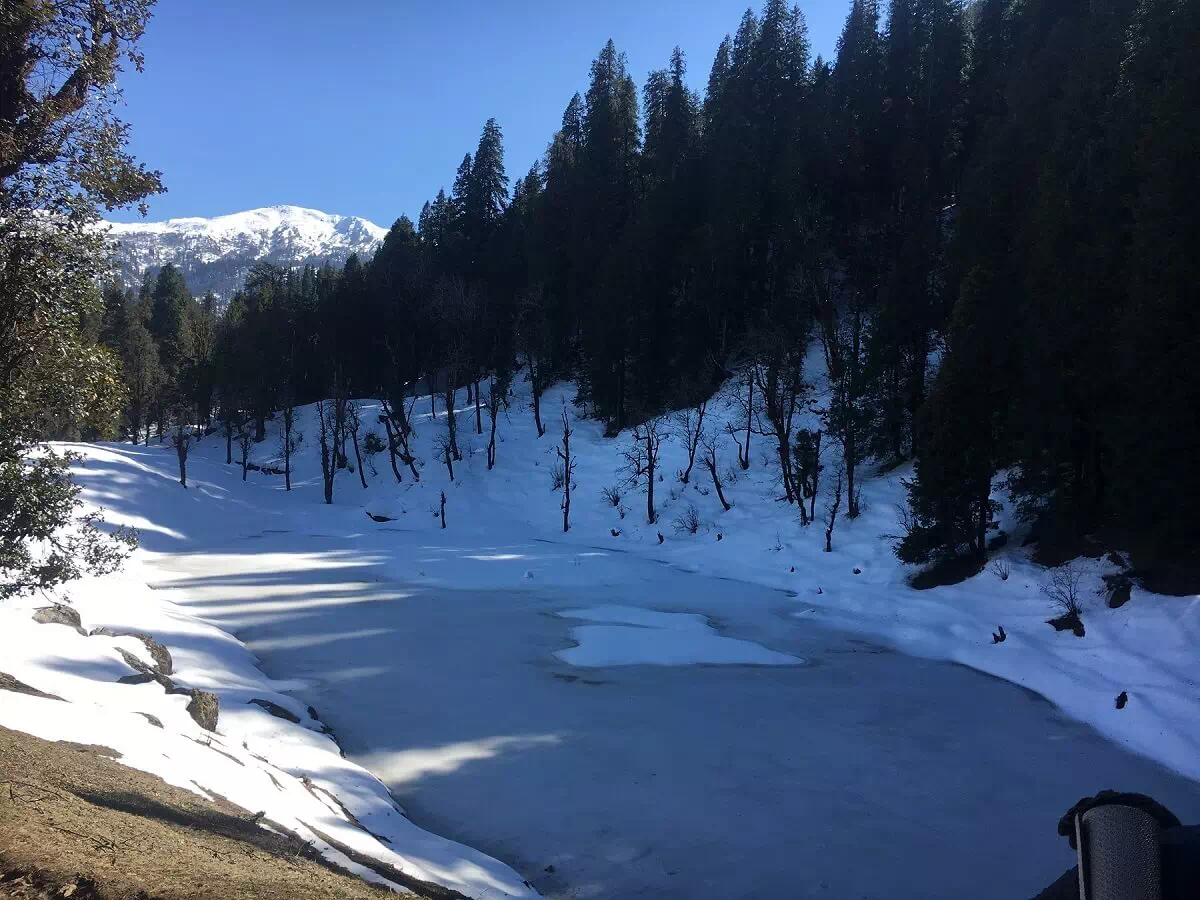






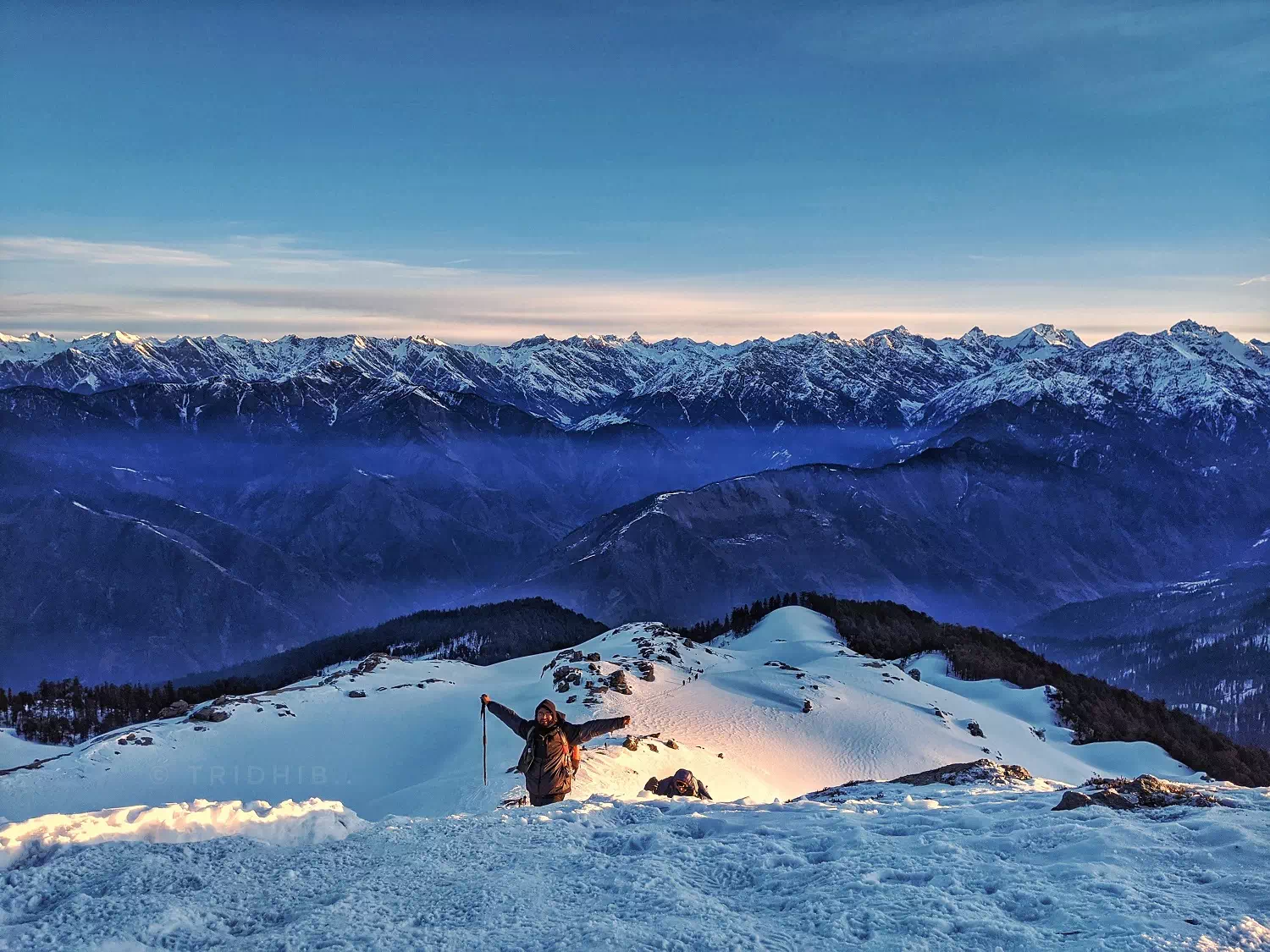




Treks by Categories
Treks By Month

Treks By Experience


